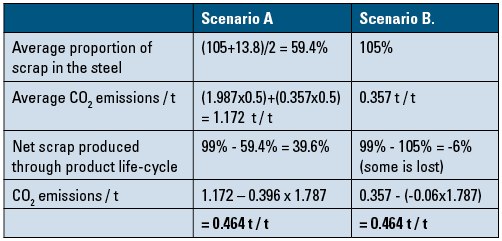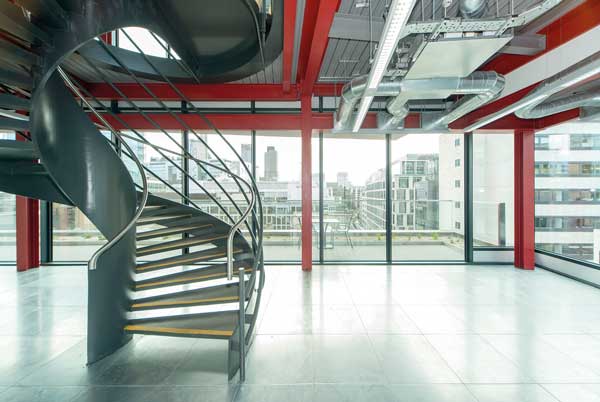Projects and Features
The carbon footprint of steel
How the embodied carbon content of steel should be calculated using the system expansion method which is widely regarded as the most comprehensive formula.
To accurately establish the environmental impact of steel manufacture, the World Steel Association (Worldsteel) uses the ‘system expansion’ method of life-cycle assessment. This is the most comprehensive assessment method currently available and is the preferred approach of the ISO 14040 series of environmental standards. The values in Table 1 have been derived from an extensive dataset collected by Worldsteel using the ‘system expansion’ method.
It is standard practice to express carbon and energy impacts on a per tonne basis, which can give the false impression that steel has higher impacts than other construction materials. However, steel has a high strength-to-weight ratio, which means that the weight of steel required, for a given application, is often much less than for the alternatives.
There are other values in circulation from a variety of sources. Some are higher and some are lower than those quoted in Table 1. They are often derived from limited ‘cradle to gate’ analysis that consider the first manufacture and use of a product, but ignore the impacts or benefits associated with the treatment of a product at the end of its life. Highly recycled materials, such as metals, are penalised by a simplified ‘cradle to gate’ analysis, whereas materials that are predominantly disposed of as waste at the end of their first life, such as timber, can be advantaged. This is clearly contrary to environmental good practice. The ‘system expansion’ method considers the full product life-cycle from ‘cradle to grave’.
Calculation of the Carbon Dioxide emissions associated with steel production
The ‘system expansion’ method credits manufacturing processes for co-products that save energy and emissions, such as process gases being used to generate electricity. Credit is also given for the net CO2 that is saved when a product is reused or recycled.
Steel is manufactured predominantly using two methods. Both methods of production require a significant input of scrap steel. The primary route uses 13.8% scrap, with emissions of 1.987 tonnes of CO2/tonne of steel. The secondary route uses 105% scrap steel, with emissions of 0.357 tonnes CO2/tonne. From these basic figures it is possible to calculate the tonnage of CO2 that is saved for each tonne of scrap steel that is recycled.
CO2 saved = (1.987 – 0.357) / (1.05 – 0.138) = 1.787 tonnes CO2 / tonne of scrap
We can now calculate the CO2 emissions associated with the production of a tonne of steel, independently of the production route. Using two scenarios demonstrates that the CO2 emissions for steel are the same irrespective of the proportions of primary and secondary sourced steel assumed.
Scenario A – assume the market sources 50% of its steel from primary production and 50% from secondary production
Scenario B – assume the market sources 100% of its steel from secondary production
In both scenarios, the same end-of-life recycling rate is used. In this case 99%, which is the value that has been demonstrated by research for steel sections in the UK.
The results in Table 2 demonstrate that the impact of steel manufacture is identical regardless of the level of recycled content. These results relate specifically to the production of steel slab for further processing into steel sections. This will vary for different products depending on the recycling rate for the particular product in question (see Table 3).
When the impacts of rolling and formation of the final product are added to those for slab manufacture, the total CO2 emissions for various steel products are shown in Table 1. The steel industry is committed to environmental and energy improvement so these values will reduce as process improvements are implemented.
Summary
The carbon footprint of steel is derived by the system expansion method
The system expansion method is the preferred approach of ISO14040
Part of steel’s clearest environmental benefit occurs at end of life with virtually guaranteed recycling or reuse. Other materials need careful end of life management to realise limited benefit.
Most carbon footprint calculations use cradle to gate data which does not take account of the full life cycle
The values in Table 1 are derived by system expansion from an extensive dataset
Carbon and energy impacts are traditionally expressed on a per tonne basis
Because of its high strength-to-weight ratio, the weight of steel required, for a given application, is generally much less than the weight of alternative materials
Steel is a highly recycled (multicycled) material via an established infrastructure in a self sustaining loop not dependent on artificial precautions or dedicated effort
Specifying by ‘recycled content’ works for materials generally sent to landfill, but it does not increase recycling rates for steel. However, it may introduce unnecessary transport costs and emissions















3 thoughts on “The carbon footprint of steel”
Comments are closed.